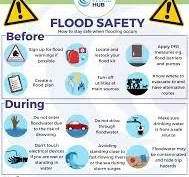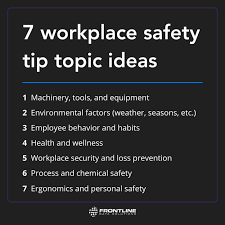Important Flood Safety Guidelines to Keep You Safe
Floods are natural disasters that can cause significant damage and pose serious risks to individuals and communities. It is crucial to be prepared and know how to stay safe during a flood event. Here are some essential flood safety guidelines to help protect yourself and your loved ones:
Before the Flood
- Stay informed about weather forecasts and flood warnings in your area.
- Create an emergency kit with essential supplies, such as food, water, medications, and first aid items.
- Develop a family emergency plan and establish evacuation routes.
- Safeguard important documents by storing them in a waterproof container or safe place.
During the Flood
- Listen to local authorities for evacuation orders and follow their instructions promptly.
- Avoid walking or driving through flooded areas, as water levels can be deceptive and hide dangerous hazards.
- If trapped in a building during a flood, move to the highest level or roof for safety.
- Turn off utilities (electricity, gas, water) at the main switch if instructed to do so by authorities.
After the Flood
- Avoid entering flooded areas until authorities declare it safe to do so.
- Inspect your home for damage before re-entering, and be cautious of potential hazards like electrical issues or structural damage.
- Clean and disinfect any items that came into contact with floodwater to prevent contamination.
- Contact your insurance company to report any flood damage and begin the claims process.
By following these flood safety guidelines before, during, and after a flood event, you can help minimize risks and protect yourself from harm. Remember that safety should always be your top priority when dealing with floods. Stay informed, stay prepared, and stay safe!
7 Key Benefits of Flood Safety Guidelines: Protecting Lives and Strengthening Communities
- Helps protect lives during flood events
- Reduces the risk of injuries and accidents
- Promotes preparedness and emergency planning
- Minimizes property damage from flooding
- Ensures access to essential supplies and resources
- Facilitates swift evacuation and rescue operations
- Supports community resilience and recovery efforts
Challenges in Adhering to Flood Safety Guidelines: Risks and Barriers
- Flood safety guidelines may not be followed by everyone, leading to increased risks for individuals and communities.
- Some people may underestimate the severity of flood warnings and fail to take necessary precautions.
- Inadequate communication or lack of access to information about flood safety guidelines can hinder preparedness efforts.
- Limited resources and funding for implementing flood safety measures can impact the effectiveness of response strategies.
- Changes in weather patterns and climate conditions may challenge the relevance and applicability of existing flood safety guidelines.
- Misinformation or conflicting advice on flood safety practices can cause confusion among the public.
- Complacency or a false sense of security following periods without flooding can lead to neglecting essential flood safety measures.
Helps protect lives during flood events
Adhering to flood safety guidelines significantly contributes to protecting lives during flood events. By following proper safety protocols, individuals can minimize the risks associated with floods and increase their chances of survival. These guidelines provide essential information on evacuation procedures, hazard avoidance, and emergency response strategies, all aimed at ensuring the safety and well-being of individuals in the face of a flood disaster. Prioritizing the implementation of flood safety measures can save lives and prevent unnecessary tragedies during challenging circumstances.
Reduces the risk of injuries and accidents
Adhering to flood safety guidelines significantly reduces the risk of injuries and accidents during flood events. By following proper safety protocols, individuals can avoid dangerous situations such as being swept away by fast-moving water, encountering electrical hazards, or getting trapped in flooded areas. Implementing preventive measures and knowing how to respond effectively can help minimize the likelihood of injuries and ensure the well-being of both individuals and communities faced with flooding.
Promotes preparedness and emergency planning
One significant advantage of flood safety guidelines is that they promote preparedness and emergency planning. By following these guidelines, individuals and communities can proactively assess potential risks, develop response strategies, and establish emergency protocols. This proactive approach helps ensure that people are better equipped to handle flood events when they occur, minimizing the impact on lives and property. Additionally, promoting preparedness through flood safety guidelines encourages a culture of resilience and readiness, fostering a safer environment for all.
Minimizes property damage from flooding
By following flood safety guidelines, individuals can effectively minimize property damage caused by flooding. Taking proactive measures such as elevating valuable belongings, installing flood barriers, and ensuring proper drainage systems can help protect homes and businesses from water intrusion. Additionally, being prepared with an emergency plan and knowing how to respond during a flood event can significantly reduce the impact of flooding on properties. By implementing these guidelines, property owners can safeguard their assets and mitigate the financial losses associated with flood damage.
Ensures access to essential supplies and resources
Adhering to flood safety guidelines ensures access to essential supplies and resources during and after a flood event. By following preparedness measures, individuals can stock up on necessary items like food, water, medications, and first aid supplies before a flood strikes. This proactive approach helps ensure that vital resources are readily available when needed, increasing the chances of survival and reducing the impact of a flood-related emergency. Additionally, being well-prepared allows for a quicker response in accessing additional support and assistance from emergency services and community organizations, ultimately enhancing overall resilience in the face of flooding disasters.
Facilitates swift evacuation and rescue operations
One crucial benefit of following flood safety guidelines is that they facilitate swift evacuation and rescue operations. By having a well-prepared emergency plan in place and adhering to safety protocols, individuals can quickly evacuate flood-prone areas when necessary, allowing first responders to focus on rescue efforts efficiently. Clear guidelines help streamline the evacuation process, ensuring that both residents and emergency personnel can navigate the situation effectively and minimize the risk of harm during a flood event.
Supports community resilience and recovery efforts
Flood safety guidelines play a crucial role in supporting community resilience and recovery efforts in the face of natural disasters. By educating individuals on preparedness measures and response strategies, these guidelines empower communities to effectively mitigate risks and minimize the impact of floods. Through proactive planning and adherence to safety protocols, communities can bounce back more swiftly after a flood event, fostering a sense of unity and strength among residents. By promoting a culture of preparedness and cooperation, flood safety guidelines contribute to building resilient communities that can recover and thrive in the aftermath of disasters.
Flood safety guidelines may not be followed by everyone, leading to increased risks for individuals and communities.
Failure to adhere to flood safety guidelines poses a significant con as not everyone may follow these crucial recommendations, ultimately resulting in heightened risks for both individuals and communities. When individuals disregard safety protocols such as evacuation orders or precautions against entering flooded areas, they not only jeopardize their own well-being but also put rescue workers and other community members at risk. Non-compliance with flood safety guidelines can lead to preventable injuries, property damage, and even loss of life, underscoring the importance of raising awareness and promoting adherence to these essential measures for the greater safety of all.
Some people may underestimate the severity of flood warnings and fail to take necessary precautions.
One significant drawback of flood safety guidelines is that some individuals may underestimate the seriousness of flood warnings and neglect to take essential precautions. This complacency can put them at risk of harm during a flood event, as they may not fully grasp the potential dangers and consequences of not following safety measures. It is crucial to raise awareness about the importance of heeding flood warnings and being proactive in preparing for floods to ensure the safety and well-being of everyone in vulnerable areas.
Inadequate communication or lack of access to information about flood safety guidelines can hinder preparedness efforts.
Inadequate communication or lack of access to information about flood safety guidelines can significantly impede preparedness efforts in at-risk communities. Without clear and accessible guidance on how to prepare for and respond to floods, individuals may not be equipped to take necessary precautions or make informed decisions during a flood event. Effective communication of flood safety guidelines is essential to ensuring that people have the knowledge and resources they need to protect themselves and their properties. Addressing this con by improving communication channels and making information readily available can help enhance overall community resilience in the face of flooding threats.
Limited resources and funding for implementing flood safety measures can impact the effectiveness of response strategies.
Limited resources and funding for implementing flood safety measures can significantly hinder the effectiveness of response strategies in mitigating the impact of floods. When communities lack the necessary financial support and resources to invest in infrastructure improvements, early warning systems, and emergency preparedness programs, their ability to respond swiftly and effectively to flood events is compromised. This con highlights the importance of allocating adequate resources and funding to ensure that comprehensive flood safety measures can be implemented to protect lives and property during times of crisis.
Changes in weather patterns and climate conditions may challenge the relevance and applicability of existing flood safety guidelines.
Changes in weather patterns and climate conditions present a significant challenge to the relevance and applicability of existing flood safety guidelines. As extreme weather events become more frequent and unpredictable, traditional safety measures may no longer provide adequate protection against evolving flood risks. It is crucial for authorities and communities to continuously reassess and update their flood safety guidelines to account for these changing conditions, ensuring that they remain effective in safeguarding lives and property in the face of a shifting climate landscape.
Misinformation or conflicting advice on flood safety practices can cause confusion among the public.
Misinformation or conflicting advice on flood safety practices can create confusion and uncertainty among the public, potentially leading to incorrect decisions and increased risks during flood events. When individuals receive contradictory guidance on how to stay safe during a flood, they may struggle to determine the best course of action, putting themselves and others in danger. Clear, accurate information from reliable sources is essential to ensure that people have the knowledge they need to effectively prepare for and respond to floods in a safe and informed manner.
Complacency or a false sense of security following periods without flooding can lead to neglecting essential flood safety measures.
Complacency or a false sense of security following periods without flooding can be a dangerous con when it comes to flood safety guidelines. During times of prolonged dry weather or when a community has not experienced flooding for an extended period, individuals may start neglecting essential flood safety measures. This can lead to a lack of preparedness and awareness when a flood event does occur, putting lives and property at risk. It is important to remain vigilant and proactive in implementing flood safety measures regardless of past experiences to ensure readiness for any potential flooding situation.




